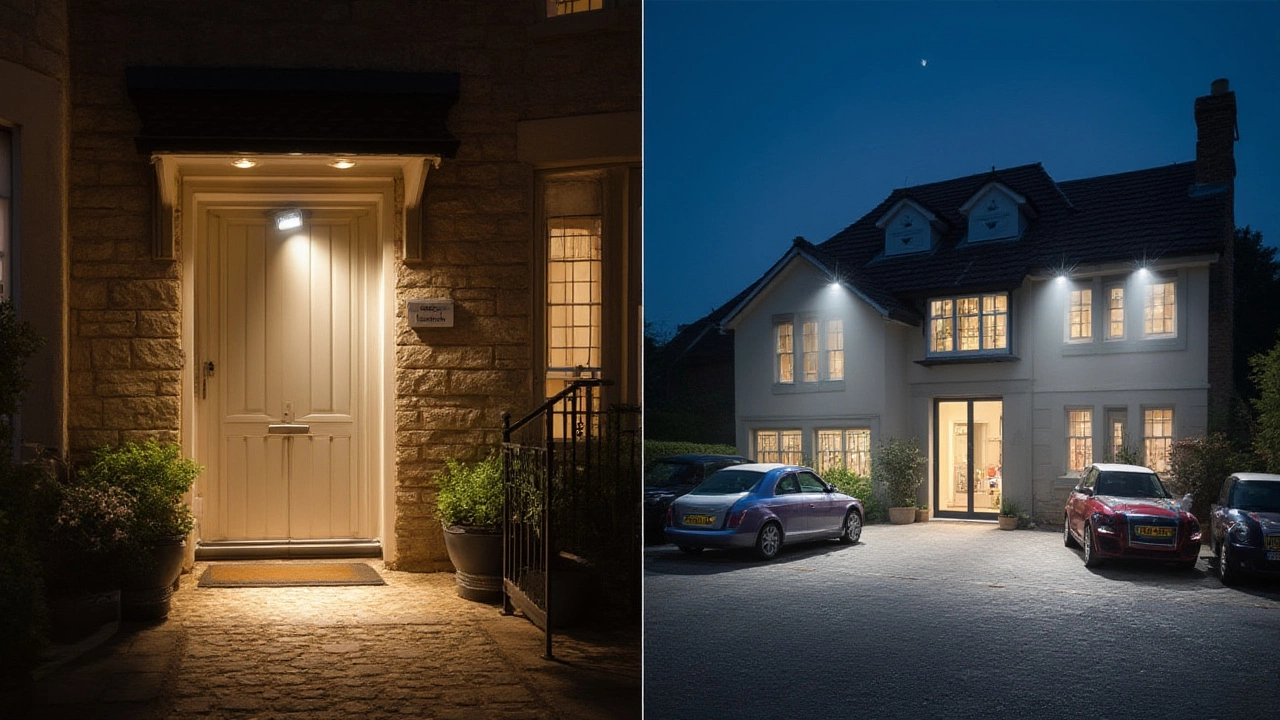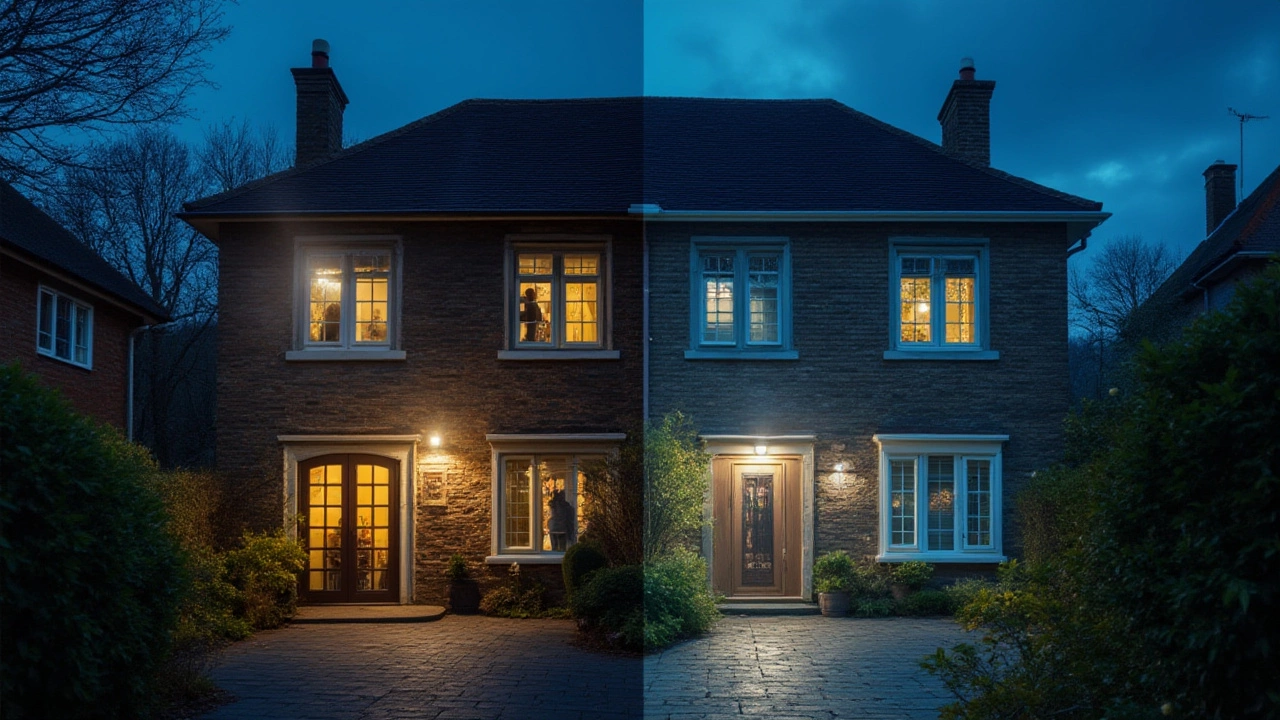Ever walked down a driveway at night, saw a blinding burst of light, and wondered if it’s a beacon for safety—or just an overenthusiastic neighbor’s outdoor flair? Outdoor lighting is more than just tossing up a bright bulb. If you’re aiming to keep your home safe, stop intruders, or just want to see the raccoons before they tip your trash cans, you’ll want to understand what sets security lights apart from floodlights. Turns out, not all bright lights are created equal. Let’s break down the real differences, and clear up the confusion once and for all.
What Exactly Is a Security Light?
Security lights aren’t just those clunky white boxes you spot on garage corners. They’re engineered to make unwanted guests feel exposed—and fast. The heart of a security light is its trigger: motion sensors, dusk-to-dawn photocells, or even fancy smartphone controls that spark the light on when needed. Picture it—a soft yard suddenly bathed in beams just as your kid’s basketball rolls out of the shadow. Or, a light that pops on only when someone—or something—actually moves into view. You don’t get constant glare, just strategic flashes that say, “Hey, I see you!”
Most security lights focus tightly on doors, walkways, or any entry points, with an emphasis on function over glow. They’re usually LED-based these days, so electricity bills don’t climb, and many can be dialed to different sensitivities, depending on your needs. Want your light to ignore squirrels but catch prowlers? You can set the range.
Another perk—security lights come in styles to blend in, not stand out. From sleek, minimalist frames to rugged fixtures that look like something off an action movie set, you can mix function with a look that fits your place.
Now here’s an eye-opener: The American Crime Prevention Institute shared that houses with some form of activated security lighting (like motion-based) saw, on average, 25% fewer burglary attempts compared to darkened neighbors. The logic is simple—burglars crave shadow, not a sudden spotlight.
Security lights aren’t just about scaring off the bad guys, though. They’re about peace of mind. Need to step out at night or grab a late delivery? No worries—the area lights up without fumbling for your phone’s flashlight. And since most security lighting manufacturers offer waterproof ratings (often IP65 or higher), rain or snow barely dents their performance.
The thing with security lights—you decide when and how they do their job. Whether wired to your home’s circuit or battery-powered (hello, renters), there are versions for every layout. And installation? Many models are so plug-and-play, you’ll spend more time deciding where to point them than actually putting them up. Painless, unless you count standing on the ladder.
One quirky fact: Some new security lights can link to smart systems, letting you customize how long the light stays on after activation, send alerts to your phone, or even snap a photo if something moves into the frame. Welcome to defensive lighting, 2025 style.
How Floodlights Work (and Where They Shine)
Floodlights aren’t subtle. They throw out tons of light, splashing huge areas with brightness that can rival city street lamps. Think stadiums, parking lots, your neighbor’s suspiciously well-lit side yard—you get the idea. Their key feature is the wide beam angle, often 100 degrees or more. That means if you install one atop your garage, you’ll likely cover your whole driveway, part of your lawn, and maybe your mailbox too.
Technically, floodlights get their name from how they “flood” a big chunk of space with light, usually hitting at least 1,500 lumens per fixture, and often way more. By comparison, basic porch lights chime in at around 800 lumens or less. They’re hardcore enough for night games or construction sites, but accessible enough that you can buy a DIY model from any big-box store.
Unlike targeted security lights, floodlights are built for coverage, not subtlety. Need to see what’s lurking at the far end of a large yard? The floodlight’s your pal. But—and this is big—they’re almost always manually controlled, or on a timer. Some models have motion sensors, but those are hybrid designs, bleeding into the ‘security light’ camp.
Here’s a funny thing: A floodlight with no motion sensor can actually make a house more of a target. According to a joint report by the International Association of Certified Home Inspectors and the US Department of Justice, permanent, always-on floodlighting sometimes gave burglars perfect visibility to pick door locks or avoid tripping—hardly ideal. It’s a strange twist, but that’s why some homeowners add motion triggers or couple floodlights with nighttime cameras.
Floodlights, though, are indispensable for backyard games, outdoor workspaces, or hosting a midnight BBQ. The most common bulbs? LEDs again, thanks to their lower running cost and longevity (good ones hit over 50,000 hours before you’ll even think of replacing them). If you’re wondering how much that matters: running a 20-watt LED floodlight for eight hours a night racks up less than $15 annually on your power bill. Want to compare specs? Here’s a simple chart for modern lighting types:
| Light Type | Common Power (Watts) | Lumens | Beam Angle | Motion Sensor? |
|---|---|---|---|---|
| Security Light | 8-15W (LED) | 500-1,000 | 20°–60° | Yes/Optional |
| Floodlight | 15-50W (LED) | 1,500-5,500+ | 90°–140° | Rare/Occasional |
| Porch Light | 5-10W (LED) | 450-800 | 180° | Rare |
Floodlights sure offer plenty of punch, but they’re best suited for places where wide, uninterrupted light is key—not stealthy, smart security.

The Core Differences: Security Light vs Floodlight
It’s tempting to lump security lights and floodlights together—bright is bright, right? But that’s like saying a spotlight and a streetlamp are cousins. Here’s where these two split:
- Beam Angle and Coverage: Security lights keep it tight, focusing on specific zones (think 20-60 degrees), while floodlights sweep wide spaces with angles from 90 up to 140 degrees.
- Activation Style: Security lights love automatic triggers—motion, dusk sensors, or smart timers. Floodlights usually prefer manual switches, but a few get motion upgrade kits.
- Purpose: Security lights are about intimidation and alerting—the “surprise, you’re caught!” factor. Floodlights are about visibility for work, play, or access—excellent for evening yard projects but not so hot for foxing burglars.
- Install Location: Security lights are placed at entrances, doorways, or key pathways where intruders might pass. Floodlights go up high (garages, poles, eaves) to cover whole yards or lots.
- Brightness: Yes, both can go bright, but floodlights win the lumen-per-dollar race every time. Security lights rarely hit the monstrous flows you’ll see from a well-installed floodlight.
- Energy Use: Since security lights turn on only as needed, they generally consume less power compared to floodlights that stay on for hours.
- Security Impact: A study from the University of North Carolina showed that properties with properly installed motion-detection security lights saw a 30% drop in burglary attempts, while always-on, broad-area lighting provided no noticeable change, or occasionally, a bump in targeted crimes.
Imagine you’re planning your yard. If you want to light up a sports court for an evening match, you want a floodlight. If you want to stop a prowler from sneaking up to the back door, a sharp, smart security light is your first defense. It’s all about putting the right tool in the right place.
A tip: Most folks overdo it with brightness. Instead of stacking three 5,000-lumen floodlights and frying the neighbors’ retinas, blend smaller, targeted security lights at doorways, then add a single medium floodlight for open areas if you need. Smart layering beats overkill any day.
Choosing the Right Outdoor Lighting for Your Needs
So, what do you really need? It comes down to what you’re worried about—or what you value. If crime’s your top concern, motion-activated security lights should go by every door or side entrance. Place them seven to nine feet high; that’s low enough to startle, but high enough to avoid vandal hands.
Floodlights make sense for big, open spaces: driveways, large patios, workshops, or places where you just need to see everything at night. Fans of late-night basketball, those with tool sheds out back, or pet-lovers who patrol for coyotes—floodlights have you covered. Motion sensor add-ons are worth the extra bucks if you flinch every time a squirrel dashes by.
A decent combo of both worlds? Mix a security light at the back door with a wide-angle flood covering the driveway. Newer all-in-one fixtures even let you toggle modes. And don’t forget color temperature—warmer (3,000K) is more relaxing, while cool white (5,000K+) feels more like daylight, perfect for catching the odd raccoon.
Here are some super-useful pointers for your setup:
- Test areas at night before installing; shadows can fool you.
- Use shielded or downward-facing fixtures to avoid light pollution—your neighbors will thank you.
- Pair security lights with security cameras for a double-whammy. Some models work together, lighting up when the camera detects a car or person.
- If you’re in a place with lots of wind, choose sturdier fixtures and weatherproof wiring. It’s boring advice, but nobody likes flickering when a storm rolls in.
- Check local rules—some neighborhoods or towns frown on hyper-bright setups.
Here’s a stat worth remembering: Energy Star researchers found that LED security lights use around 75% less electricity than halogen or incandescent styles from ten years ago. So don’t sweat the small stuff when choosing LEDs over “old-school” bulbs—you’ll save big, and get better performance.
And don’t let fancy branding sway you—always check the lumens, beam angle, and sensor details first. Nothing’s worse than buying a “security” light that’s more like a cheap flashlight taped to your gutter.
When all’s said and done, outdoor lighting isn’t rocket science—but picking the right one makes a way bigger difference than most folks think. Home is home, and seeing things clearly (or hiding them well) is more than just flipping a switch.

